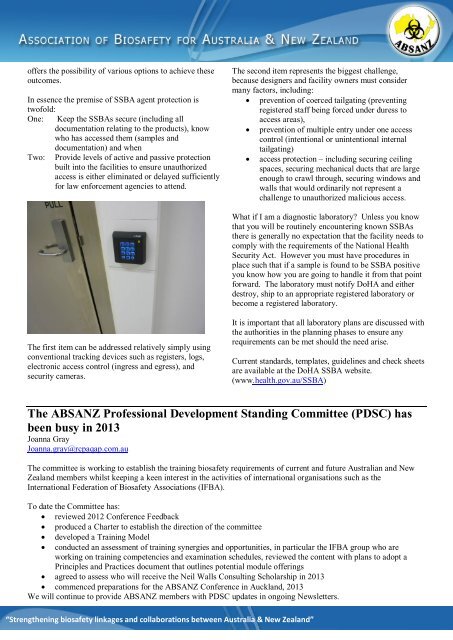Newsletter Issue 01 June 2013 - absanz
Newsletter Issue 01 June 2013 - absanz
Newsletter Issue 01 June 2013 - absanz
You also want an ePaper? Increase the reach of your titles
YUMPU automatically turns print PDFs into web optimized ePapers that Google loves.
offers the possibility of various options to achieve these<br />
outcomes.<br />
In essence the premise of SSBA agent protection is<br />
twofold:<br />
One: Keep the SSBAs secure (including all<br />
documentation relating to the products), know<br />
who has accessed them (samples and<br />
documentation) and when<br />
Two: Provide levels of active and passive protection<br />
built into the facilities to ensure unauthorized<br />
access is either eliminated or delayed sufficiently<br />
for law enforcement agencies to attend.<br />
The second item represents the biggest challenge,<br />
because designers and facility owners must consider<br />
many factors, including:<br />
• prevention of coerced tailgating (preventing<br />
registered staff being forced under duress to<br />
access areas),<br />
• prevention of multiple entry under one access<br />
control (intentional or unintentional internal<br />
tailgating)<br />
• access protection – including securing ceiling<br />
spaces, securing mechanical ducts that are large<br />
enough to crawl through, securing windows and<br />
walls that would ordinarily not represent a<br />
challenge to unauthorized malicious access.<br />
What if I am a diagnostic laboratory? Unless you know<br />
that you will be routinely encountering known SSBAs<br />
there is generally no expectation that the facility needs to<br />
comply with the requirements of the National Health<br />
Security Act. However you must have procedures in<br />
place such that if a sample is found to be SSBA positive<br />
you know how you are going to handle it from that point<br />
forward. The laboratory must notify DoHA and either<br />
destroy, ship to an appropriate registered laboratory or<br />
become a registered laboratory.<br />
The first item can be addressed relatively simply using<br />
conventional tracking devices such as registers, logs,<br />
electronic access control (ingress and egress), and<br />
security cameras.<br />
It is important that all laboratory plans are discussed with<br />
the authorities in the planning phases to ensure any<br />
requirements can be met should the need arise.<br />
Current standards, templates, guidelines and check sheets<br />
are available at the DoHA SSBA website.<br />
(www.health.gov.au/SSBA)<br />
The ABSANZ Professional Development Standing Committee (PDSC) has<br />
been busy in 2<strong>01</strong>3<br />
Joanna Gray<br />
Joanna.gray@rcpaqap.com.au<br />
The committee is working to establish the training biosafety requirements of current and future Australian and New<br />
Zealand members whilst keeping a keen interest in the activities of international organisations such as the<br />
International Federation of Biosafety Associations (IFBA).<br />
To date the Committee has:<br />
• reviewed 2<strong>01</strong>2 Conference Feedback<br />
• produced a Charter to establish the direction of the committee<br />
• developed a Training Model<br />
• conducted an assessment of training synergies and opportunities, in particular the IFBA group who are<br />
working on training competencies and examination schedules, reviewed the content with plans to adopt a<br />
Principles and Practices document that outlines potential module offerings<br />
• agreed to assess who will receive the Neil Walls Consulting Scholarship in 2<strong>01</strong>3<br />
• commenced preparations for the ABSANZ Conference in Auckland, 2<strong>01</strong>3<br />
We will continue to provide ABSANZ members with PDSC updates in ongoing <strong>Newsletter</strong>s.<br />
“Strengthening biosafety linkages and collaborations between Australia & New Zealand”


